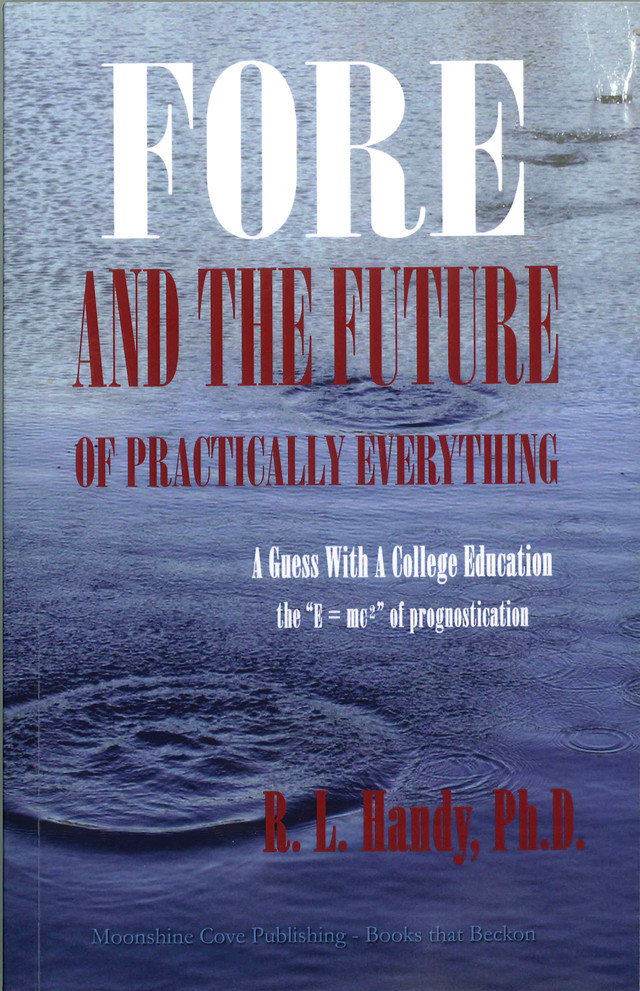
by Jacob Haqq-Misra Tuesday, July 26, 2016

"FORE and the Future of Practically Everything," by R. L. Handy, Moonshine Cove Publishing, LLC, 2013, ISBN-13: 978-1937327316.
What if we could project the future of nearly everything with a single type of mathematical equation? In “FORE and the Future of Practically Everything,” a book replete with humor and keen insight, retired civil and geotechnical engineer Richard L. Handy valiantly attempts to demonstrate the projective power of mathematics by exploring an eclectic assortment of examples.
Handy applied some concepts from his days in geotechnical engineering to a wider assortment of topics. FORE, short for “first-order rate equation,” is a tidy mathematical tool to analyze and interpret trends in data and project where these trends may lead in the future. Handy’s approach reduces the complex calculus of rates of change into a visual expression of a line on a graph; this simplification yields a first-cut (or “first-order”) description of how we could mathematically predict the final state of a system.
As his initial example, Handy describes — with characteristic avuncular humor — an experiment that he and his wife conducted on a rural countryside road to simulate running out of gas in one’s car. Armed with only a stopwatch, pen and notepad, they reached 60 miles per hour (mph) before shifting into neutral and recording their slowdown — without acceleration or braking — to about 10 mph (when they met an unsuspecting tractor in their path); the point was to demonstrate that useful and interesting data can be obtained from the simplest of experiments. Handy analyzes the rate at which the car slowed using FOREs — liberally using graphs to illustrate the concept of his mathematical method. A basic lesson from this simple example is the nonlinearity of coasting, which Handy summarizes succinctly as “the slower we were going, the slower we slowed down.”
Handy provides graphs of his empirical data with best-fit curves added in as a means of contrast throughout the book. Best-fit lines, he argues, give us information only over the range of data examined, but they cannot necessarily say anything about the future. For example, the best-fit curve for his car-coasting experiment predicts that the car will eventually have a negative velocity, which is a meaningless result. Using FOREs to analyze the rate of change of velocity, on the other hand, can help project the future speed by assuming a logarithmic decrease in speed that fits the data.
Handy is quick to point out shortcomings in his own analysis when FOREs do not offer an exact match to data. Nonetheless, he argues for FOREs as a useful tool to aid our thinking about the way in which processes slow down into the future.
Handy touches on a wide assortment of topics, including ice-breaking ships, pole vaulters, track runners, homerun sluggers and horse racing, to illustrate conceptual aspects of FOREs. He notes that in many instances, the pattern of FOREs is interrupted by what Handy calls a “major event” that represents a major breakthrough in technology. The introduction of the fiberglass pole in pole vaulting is one example: Handy uses FOREs to show that vaulters significantly improved their jumps due to this particular innovation, with a drastic increase of about 23 percent in the highest attainable jumps. The introduction of paved track from cinders is another such major event that significantly improved sprinting times.
Other topics he touches on include global climate change, population growth, oil shortages and life expectancy. Handy uses careful rhetoric, wrought with persistent humor — for example, he blames the shape of the statistical Bell curve on “a bad day at the foundry” — to avoid making presumptions about sometimes controversial issues. He focuses on what the data show and how this method can aid in analysis. Global population has not yet leveled off and is therefore premature for FORE analysis, but the populations of certain nations and U.S. states do show trends that can be projected into the future. Handy also discusses how FOREs may not be useful for analyzing rises in global average temperature because it implies that the current warming trend shows no signs of slowing.
The book is an excellent read for a wide audience. It provides enough detail and raw data and is well-enough explained that it could be used as an introduction to differential equations in an undergraduate or graduate course, yet even senior faculty will likely enjoy some of the historical anecdotes and unique perspectives that Handy brings.
With plenty of variety, “FORE and the Future of Practically Everything” is an enjoyable book with the power to evoke laughter and reflection; it leaves a lasting impression.
© 2008-2021. All rights reserved. Any copying, redistribution or retransmission of any of the contents of this service without the expressed written permission of the American Geosciences Institute is expressly prohibited. Click here for all copyright requests.